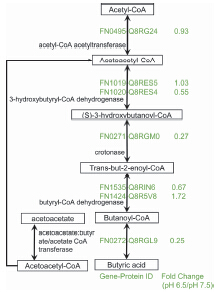| [1] Group, N. H. W.; Peterson, J.; Garges, S.; Giovanni, M.; McInnes, P.; Wang, L.; Schloss, J. A.; Bonazzi, V.; McEwen, J. E.; Wetterstrand, K. A.; Deal, C.; Baker, C. C.; Di Francesco, V.; Howcroft, T. K.; Karp, R. W.; Lunsford, R. D.; Wellington, C. R.; Belachew, T.; Wright, M.; Giblin, C.; David, H.; Mills, M.; Salomon, R.; Mullins, C.; Akolkar, B.; Begg, L.; Davis, C.; Grandison, L.; Humble, M.; Khalsa, J.; Little, A. R.; Peavy, H.; Pontzer, C.; Portnoy, M.; Sayre, M. H.; Starke-Reed, P.; Zakhari, S.; Read, J.; Watson, B.; Guyer, M. Genome Res. 2009, 19, 2317.
[2] Backhed, F.; Ding, H.; Wang, T.; Hooper, L. V.; Koh, G. Y.; Nagy, A.; Semenkovich, C. F.; Gordon, J. I. Proc. Natl. Acad. Sci. U. S. A. 2004, 101, 15718.
[3] Sjostrom, L.; Lindroos, A. K.; Peltonen, M.; Torgerson, J.; Bouchard, C.; Carlsson, B.; Dahlgren, S.; Larsson, B.; Narbro, K.; Sjostrom, C. D.; Sullivan, M.; Wedel, H.; Swedish Obese Subjects Study Scientific, G. N. Engl. J. Med. 2004, 351, 2683.
[4] Tremaroli, V.; Backhed, F. Nature 2012, 489, 242.
[5] Bolstad, A. I.; Jensen, H. B.; Bakken, V. Clin. Microbiol. Rev. 1996, 9, 55.
[6] Bennett, K. W.; Eley, A. J. Med. Microbiol. 1993, 39, 246.
[7] Kapatral, V.; Anderson, I.; Ivanova, N.; Reznik, G.; Los, T.; Lykidis, A.; Bhattacharyya, A.; Bartman, A.; Gardner, W.; Grechkin, G.; Zhu, L.; Vasieva, O.; Chu, L.; Kogan, Y.; Chaga, O.; Goltsman, E.; Bernal, A.; Larsen, N.; D'Souza, M.; Walunas, T.; Pusch, G.; Haselkorn, R.; Fonstein, M.; Kyrpides, N.; Overbeek, R. J. Bacteriol. 2002, 184, 2005.
[8] Kostic, A. D.; Gevers, D.; Pedamallu, C. S.; Michaud, M.; Duke, F.; Earl, A. M.; Ojesina, A. I.; Jung, J.; Bass, A. J.; Tabernero, J.; Baselga, J.; Liu, C.; Shivdasani, R. A.; Ogino, S.; Birren, B. W.; Huttenhower, C.; Garrett, W. S.; Meyerson, M. Genome Res. 2012, 22, 292.
[9] Castellarin, M.; Warren, R. L.; Freeman, J. D.; Dreolini, L.; Krzywinski, M.; Strauss, J.; Barnes, R.; Watson, P.; Allen-Vercoe, E.; Moore, R. A.; Holt, R. A. Genome Res. 2012, 22, 299.
[10] Rubinstein, M. R.; Wang, X.; Liu, W.; Hao, Y.; Cai, G.; Han, Y. W. Cell Host Microbe 2013, 14, 195.
[11] Nugent, S. G.; Kumar, D.; Rampton, D. S.; Evans, D. F. Gut 2001, 48, 571.
[12] Navratilova, J.; Hankeova, T.; Benes, P.; Smarda, J. Chemotherapy 2013, 59, 112.
[13] Cardone, R. A.; Casavola, V.; Reshkin, S. J. Nat. Rev. Cancer 2005, 5, 786.
[14] Zheng, J. F.; Sun, C. Y.; Sun, L. C.; Yang, X. M.; Wang, X. Z.; Huang, Y.; Li, Y.; He, J. Q. Acta Chim. Sinica 2010, 68, 996. (郑君芳, 孙超渊, 孙丽翠, 杨晓梅, 王小柱, 黄艳, 李洋, 贺俊崎, 化学学报, 2010, 68, 996.)
[15] Xu, F. F.; Sun, S.; Liu, X. H. Acta Chim. Sinica 2006, 64, 543. (徐菲菲, 孙胜, 刘秀华, 化学学报, 2006, 64, 543.)
[16] Liu, X. H.; Yin, X. F.; Shen, H. L.; Lu, H. J.; Yang, P. Y. Sci. Sinica (Chimica) 2014, 44, 739. (刘晓慧, 殷薛飞, 申华莉, 陆豪杰, 杨芃原, 中国科学, 2014, 44, 739.)
[17] Hebert, A. S.; Richards, A. L.; Bailey, D. J.; Ulbrich, A.; Coughlin, E. E.; Westphall, M. S.; Coon, J. J. Mol. Cell. Proteomics 2014, 13, 339.
[18] Beck, M.; Schmidt, A.; Malmstroem, J.; Claassen, M.; Ori, A.; Szymborska, A.; Herzog, F.; Rinner, O.; Ellenberg, J.; Aebersold, R. Mol. Syst. Biol. 2011, 7, 549.
[19] Ohigashi, S.; Sudo, K.; Kobayashi, D.; Takahashi, O.; Takahashi, T.; Asahara, T.; Nomoto, K.; Onodera, H. Dig. Dis. Sci. 2013, 58, 1717.
[20] Pryde, S. E.; Duncan, S. H.; Hold, G. L.; Stewart, C. S.; Flint, H. J. FEMS Microbiol. Lett. 2002, 217, 133.
[21] Scharlau, D.; Borowicki, A.; Habermann, N.; Hofmann, T.; Klenow, S.; Miene, C.; Munjal, U.; Stein, K.; Glei, M. Mutat. Res. 2009, 682, 39.
[22] Han, Y. W. Curr. Protoc. Microbiol. 2006, Chapter 13, Unit 13A 1
[23] .Huang, D. W.; Sherman, B. T.; Lempicki, R. A. Nature Protoc. 2009, 4, 44. |
